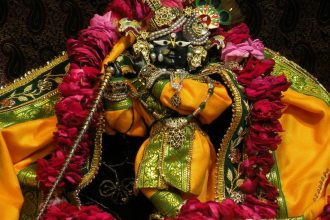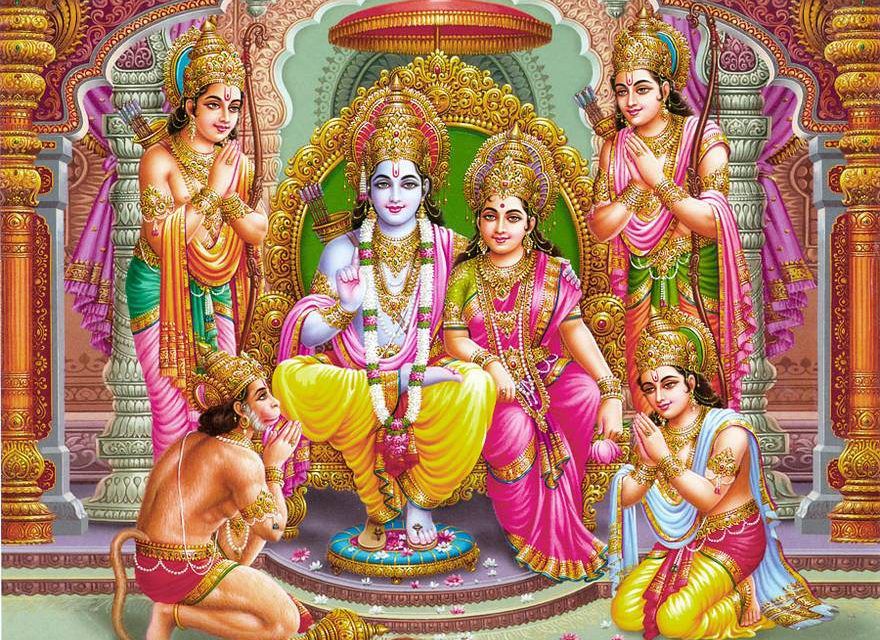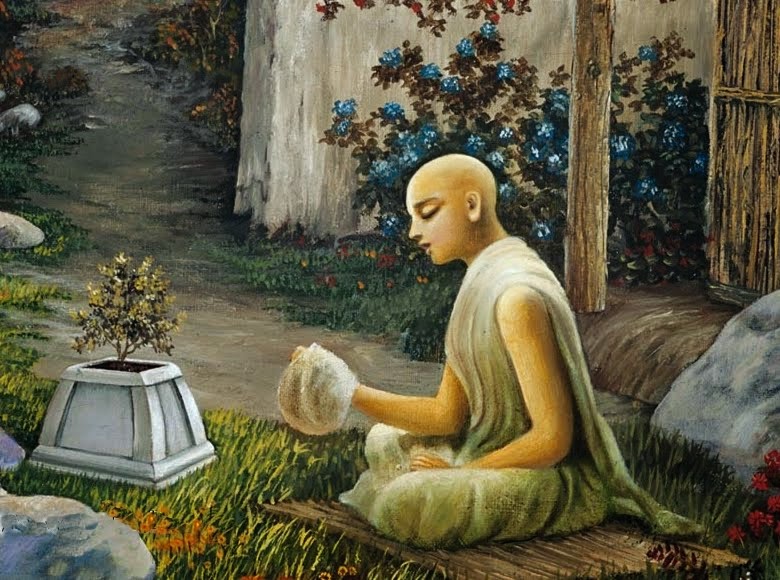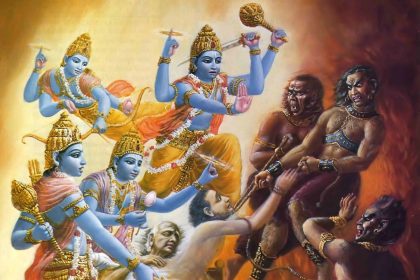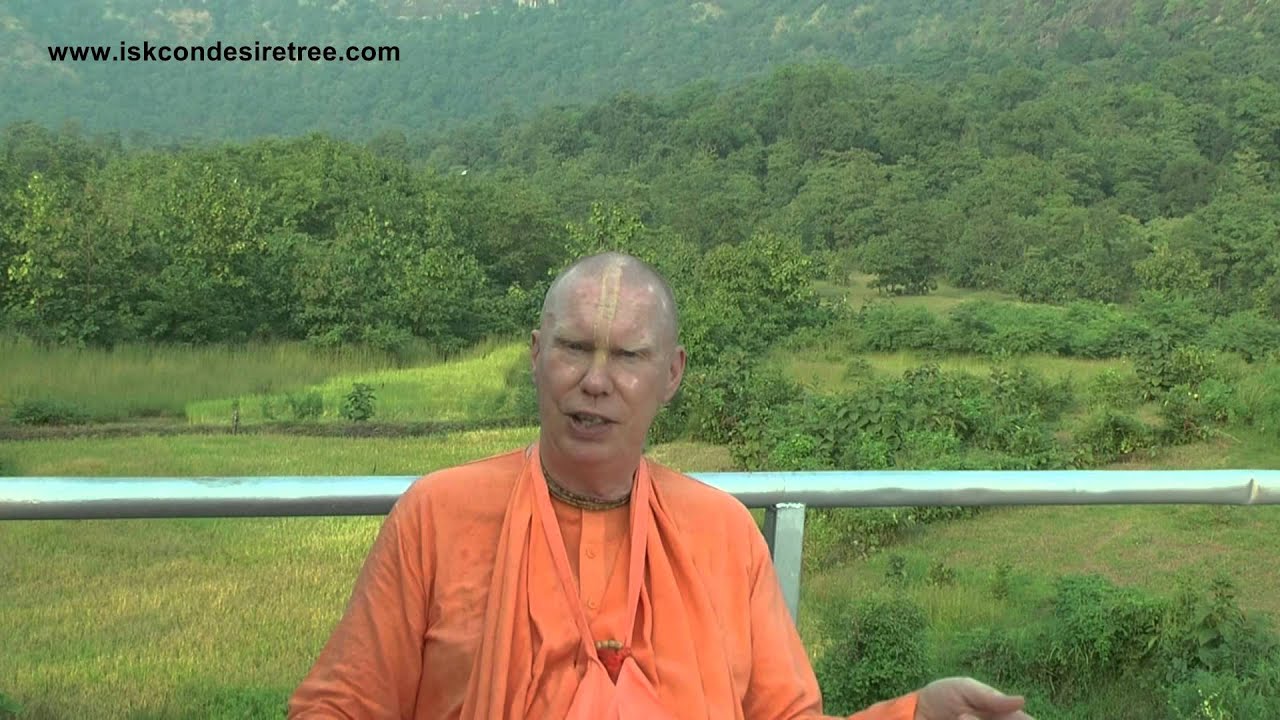Serving the Holy Name (nāma-sevā)
In His Śikṣāṣṭaka, Lord Caitanya Mahāprabhu describes the magnanimity of the holy name:
nāmnām akāri bahudhā nija-sarva-śaktis
tatrārpitā niyamitaḥ smaraṇe na kālaḥ
etādṛśī tava kṛpā bhagavan mamāpi
durdaivam īdṛśam ihājani nānurāgaḥ
My Lord, O Supreme Personality of Godhead, in Your holy name there is all good fortune for the living entity, and therefore You have many names, such as Kṛṣṇa and Govinda, by which You expand Yourself. You have invested all Your potencies in those names, and there are no hard and fast rules for remembering them. My dear Lord, although You bestow such mercy upon the fallen, conditioned souls by liberally teaching Your holy names, I am so unfortunate that I commit offenses while chanting the holy name, and therefore I do not achieve attachment for chanting. [Śrī Śikṣāṣṭaka 2]
Śrīla Kṛṣṇadāsa Kavirāja records this exchange between Sārvabhauma Bhaṭṭācārya and Śrī Caitanya Mahāprabhu: “Then the Bhaṭṭācārya asked Caitanya Mahāprabhu: ‘Which item is most important in the execution of devotional service?’ The Lord replied that the most important item was the chanting of the holy name of the Lord.” (Cc. Madhya 6.241)
Although chanting the holy name of the Lord is one of the five principal activities of sādhana-bhakti and the very life of devotional service in the Age of Kali, we may also consider it an aspect of svādhyāya, one of the five aspects of arcana. Since this book deals with rules and regulations prescribed in pañcaratrikī-vidhi, we will confine our treatment of nāma-sevā to setting out practical guidelines that promote offenseless chanting, particularly in chanting japa.
The rules for chanting japa that are given in the scriptures apply specifically to the chanting of Gāyatrī mantras. By contrast, the holy name does not depend on such rules to be effective. However, since many of these rules help one concentrate on the mantra, a devotee may apply them in chanting the holy name to fix his mind on Kṛṣṇa and to avoid offenses to the holy name. Śrīla Prabhupāda states:
The Hare Kṛṣṇa mahā-mantra, however, may be chanted at any place and any time, and this will bring results very quickly. Yet even while chanting the Hare Kṛṣṇa mantra one may observe regulative principles. Thus while sitting and chanting one may keep his body straight, and this will help one in the chanting process; otherwise one may feel sleepy. [SB 7.15.31, purport]
Counting Japa
In the following passage from the Caitanya-caritāmṛta (Antya 3.137, purport), Śrīla Prabhupāda explains how he is training his disciples to advance in their spiritual life:
In our Kṛṣṇa consciousness movement we are teaching our followers to chant the Hare Kṛṣṇa mantra continuously on beads. Even those who are not accustomed to this practice are advised to chant at least sixteen rounds on their beads so that they may be trained. Otherwise, Śrī Caitanya Mahāprabhu recommended:
tṛṇād api su-nīcena taror iva sahiṣṇunā
amāninā māna-dena kīrtanīyaḥ sadā hariḥ
‘One should chant the holy name of the Lord in a humble state of mind, thinking oneself lower than the straw in the street. One should be more tolerant than a tree, devoid of all sense of false prestige, and ready to offer all respects to others. In such a state of mind one can chant the holy name of the Lord constantly.’ Sadā means ‘always.’ Haridāsa Ṭhākura says, nirantara nāma lao: ‘Chant the Hare Kṛṣṇa mantra without stopping.’ [Cc. Antya 3.137, purport]
Śrīla Prabhupāda explains that there is no restriction in chanting the holy name of the Lord. He writes:
Even when you are walking, you can softly chant Hare Krishna, Hare Krishna, or even when you are on the bus going to somewhere you can also chant. When you are working with your hands you can also chant, and when you are resting or going to take rest you can also chant. Even in your toilet room while taking bath you can also chant. In this way there is no limitation or restriction for chanting the Holy Name of God, Krishna, and His Energy, Hara. In doing this business there is no loss, but there is very great gain, which is transcendental realization. [letter from Śrīla Prabhupāda, 22 April 1970]
You should string your beads (preferably of tulasī or nīm wood) on cotton thread and tie a knot between each bead. There should be one extra bead, called the Kṛṣṇa or Meru bead, which you do not cross over in your counting. Between the eighth and ninth bead from the Meru bead on one side there should be a short braided thread marking off the first eight beads, which represent the eight principal gopīs. After stringing the beads, you may perform a mālā-saṁskāra by washing the japa-mālā in pañca-gavya (five products from the cow: milk, yoghurt, ghee, dung, and urine). Then you should offer the mālā to the Deity.
Gauḍīya Vaiṣṇavas chant on their beads using the thumb and middle finger of the right hand. You should avoid touching the mālā with your left hand or your right forefinger. Cover the beads and your right hand while chanting by keeping them in a bead bag. (It is not necessary to cover the beadbag with a chādar while chanting, as some Vaiṣṇavas in India think.) Try to prevent the mālā from falling from your fingers-usually a result of inattention or dozing!
Since chanting the holy name brings you into direct association with the Lord, while chanting you should be clean and properly dressed, with kaṇṭhī-mālā around your neck and Vaiṣṇava tilaka on your body. Also, you should regularly wash your bead bag.
Handle your chanting beads with respect and always keep them clean. Avoid touching your beads with unclean hands, i.e., hands that have not been washed after you have eaten, evacuated, or touched unclean objects like the mouth, feet, or private parts. As far as possible, avoid taking chanting beads into a toilet room. If you accidentally mishandle your chanting beads, you may touch them to your head and pray for forgiveness.
Posture, Place, and Time
Śrīla Prabhupāda was very strict about how the devotees carried themselves while chanting. On one occasion, while chanting japa with a group of devotees, he demanded of one of them, “Sit properly!”
While chanting japa, you should sit with your back erect and your legs crossed and covered, not spread out. Do not lie down while chanting japa. It is also recommended that you sit on an āsana.
You should chant japa in front of a Deity of Lord Kṛṣṇa or Viṣṇu, in a temple of the Lord (or in any other place where He is worshiped), in front of a sacred tulasī plant, or by the side of a sacred river, such as the Ganges.
Chant in well-lit places rather than dark places, in holy places rather than impure places (such as a crematorium).
The preferred chanting time is early morning. If you have other services in the early morning, schedule your japa chanting as soon as possible after completing your other duties.
In this regard Śrīla Prabhupāda writes:
Chanting japa should be done early in the morning with full concentration preferably during the Brahma-Muhurta time. Concentrate fully on the sound vibration of the mantra, pronouncing each name distinctly, and gradually your speed in chanting will increase naturally. Do not worry so much about chanting fast; most important is the hearing. [letter from Śrīla Prabhupāda, 6 January 1972]
Srila PrabhupadaAttention while Chanting
Try to withdraw your mind from the objects of the senses, exclusively concentrate on the sounds of the mantra, meditate on the meaning of the mantra, and remain undisturbed by any other thoughts or external situations. Through devoted concentration on the syllables of the holy name, you will realize step-by-step the Lord’s form, qualities, and pastimes.
Source: Pañcarātra-Pradīpa – ISKCON GBC Press / Volume 1, Daily Service, (Nitya-Sevā) / Cultivation of Devotional Service, Aspects of Svādhyāya, Sādhana, and Sad-ācāra


